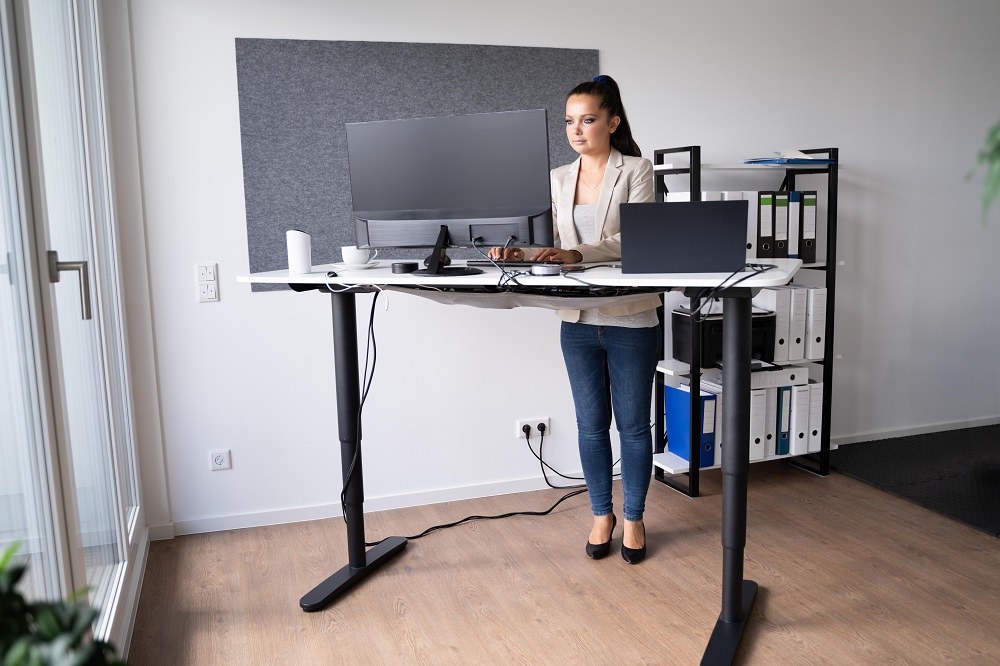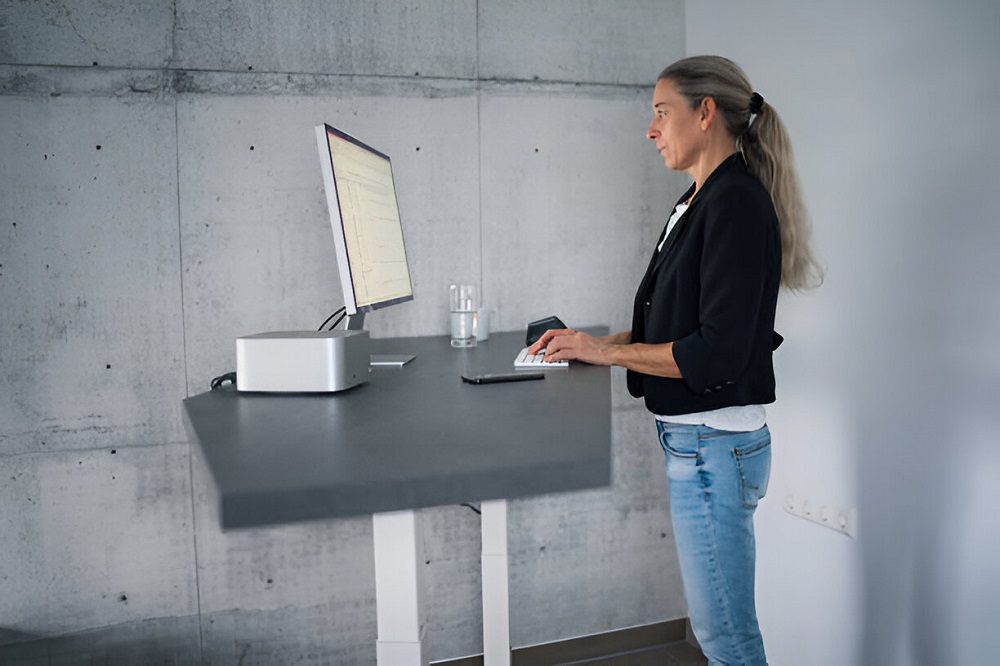Standing desks have become a ubiquitous feature in modern workplaces, lauded for their ability to combat the health risks associated with a sedentary lifestyle. However, simply ditching your chair for a standing desk isn't a magic bullet for good posture. In fact, improper standing desk posture can lead to a new set of aches and pains.
This guide delves into the world of standing desk posture, exploring common mistakes and equipping you with the knowledge and techniques to achieve optimal alignment throughout your workday. By incorporating these tips, you can unlock the true potential of your standing desk and experience a surge in productivity and improved health.
The Importance of Posture: Beyond Standing vs. Sitting
Posture refers to the position of your body at rest or in motion. Maintaining proper posture, whether sitting or standing, is crucial for optimal health. It ensures the even distribution of weight across your joints and muscles, preventing strain and fatigue. Good posture also promotes better circulation, breathing, and even digestion.
While standing desks offer a clear advantage over sitting all day, neglecting proper standing desk posture can lead to issues like neck pain, lower back pain, and even carpal tunnel syndrome. Conversely, maintaining proper posture at desk, whether standing or sitting, can significantly reduce these risks and contribute to a more comfortable and productive work experience.
The 5 Pillars of Proper Standing Desk Posture
Let's break down the five most common posture mistakes that plague standing desk users and explore effective solutions to transform your workday posture:
1. The Hunchback of the Desky Way: This classic posture problem transcends positions. Slouching, whether sitting or standing, throws your entire body out of alignment. When working at a standing desk, hunching forward shortens your neck muscles and strains your back, leading to pain and fatigue.
The Fix: Imagine a straight line running from your earlobe through your shoulder and hip. Stand tall with your shoulders relaxed and pulled back. Engage your core by gently pulling your belly button towards your spine. This "tall spine" position distributes your weight evenly and takes the strain off your lower back.
2. The Weary Flamingo: Standing for extended periods can tire your legs, but don't succumb to the temptation of constantly leaning on one hip. This throws your pelvis out of alignment, leading to lower back pain and potentially sciatica.
The Fix: Stand with your feet hip-width apart and distribute your weight evenly. Shift your weight from one foot to the other periodically to keep your circulation flowing and prevent fatigue. Think of it as a gentle, constant micro-movement throughout the day.
3. Flat Feet Blues: Standing all day on a hard floor can be unforgiving on your feet, especially if you have flat feet. Flat feet can exacerbate existing posture problems by affecting your balance and causing you to subconsciously shift your weight in unhealthy ways.
The Fix: Invest in an anti-fatigue mat. These cushioned mats provide much-needed support and comfort, reducing stress on your feet and ankles. Additionally, ergonomic footwear designed for standing desks should be considered, as it often promotes better posture and circulation.
4. The Downward Gaze: Just because you're standing doesn't mean your monitor's height gets a free pass. Craning your neck down to see your screen all day is a recipe for neck and shoulder pain.
The Fix: Adjust your monitor height so the top of the screen sits at or slightly below eye level. This allows you to gaze forward with a neutral neck position, preventing unnecessary strain. Ideally, your monitor arm (if you have one) should allow for easy height and depth adjustments.
5. The Statue: Standing still for hours on end isn't good for your posture or circulation. While standing offers a clear advantage over sitting all day, remaining static for extended periods can lead to stiffness and fatigue.
The Fix: Incorporate micro-movements throughout your workday. Subtly shift your weight, stretch your calves, roll your shoulders, or even take a quick walk around the office. These small movements help to keep your blood flowing and prevent your muscles from becoming overly fatigued.
Beyond Standing: Correct Sitting Posture at Your Desk

Many standing desks come with an optional sit-down feature. But here's the key: when you choose to sit, ensure you're practicing correct sitting posture at desk. This means:
- Chair Height: Adjust your chair height so your knees are bent at a 90-degree angle and your feet are flat on the floor.
- Lumbar Support: Ensure the chair's back supports your lower back's natural curve. Avoid slouching by maintaining a neutral spine.
- Armrest Alignment: Adjust the armrests so your elbows rest comfortably at a 90-degree angle while typing.
Optimizing Your Workspace for Peak Performance: Beyond Posture
While proper standing desk posture is essential, creating an ergonomic workstation takes a holistic approach. Here are some additional factors to consider for a healthy and productive work environment:
Ergonomic Keyboard and Mouse:
- A standard keyboard might force your wrists into an unnatural position. Consider a split keyboard with an ergonomic design that keeps your wrists straight and reduces strain.
- Similarly, a regular mouse can cause wrist and hand issues. Explore ergonomic mice that provide better palm support and reduce the risk of carpal tunnel syndrome.
Lighting and screen glare:
- Harsh overhead lighting or screen glare can contribute to eye strain and headaches. Invest in a desk lamp that provides adjustable, task-specific lighting. Consider an anti-glare screen protector for your monitor to further reduce eye fatigue.
Environment and Personal Preferences:
- Temperature: Maintaining a comfortable ambient temperature is crucial. A workspace that's too hot or too cold can lead to discomfort and decreased focus.
- Noise: Excessive noise can be a major distraction. Consider noise-canceling headphones or white noise machines to create a more serene work environment.
- Personalization: Don't be afraid to personalize your workspace with plants, pictures, or other items that inspire you and promote a sense of well-being.
Taking Movement Breaks: The Key to Sustainable Standing
Remember, the human body wasn't designed to stay in one position for extended periods of time. Even with proper posture, incorporating movement breaks is essential for optimal health and focus. Here are some ideas:
- The Pomodoro Technique: This time management method involves working in focused 25-minute intervals with short breaks in between. Use these breaks to get up and move around, stretch, or even do some light desk exercises.
- Desk Stretches: There are a variety of stretches you can do right at your desk to improve circulation, reduce stiffness, and maintain good posture. These include neck rolls, shoulder shrugs, arm circles, and calf raises.
- Walking Meetings: Ditch the conference room and take walking meetings whenever possible. This is a great way to get some exercise and boost creativity while still getting work done.
The Art of Active Sitting: Finding Balance Throughout the Day

While standing desks offer numerous benefits, alternating between sitting and standing is often the ideal scenario. Here are some tips for incorporating active sitting into your workday:
- Active Sitting Chairs: Consider using an exercise ball, kneeling chair, or other active sitting options that engage your core muscles and promote better posture than a traditional chair.
- Standing Desk Converters: If a full-standing desk isn't feasible, a standing desk converter can be a great alternative. These converters elevate your existing desk surface, allowing you to work while standing for part of the day.
- Listen to Your Body: Pay attention to your body's signals. If you're feeling tired or sore while standing, take a break and sit down for a while. The key is to find a balance that works best for you.
Building Sustainable Standing Habits: Consistency is Key

Transitioning to a standing desk routine requires dedication and consistency. Here are some tips to make standing a sustainable habit:
- Start Slowly: Don't try to stand for eight hours straight on day one. Begin with short standing intervals and gradually increase the duration as your body adjusts.
- Invest in Comfort: A comfortable standing desk setup is crucial for long-term success. Ensure your desk height and monitor placement are ideal for your body type. Anti-fatigue mats and ergonomic accessories can significantly improve your standing experience.
- Stay Hydrated: Proper hydration is essential for overall health and can help prevent fatigue while standing for extended periods. Keep a reusable water bottle at your desk and sip on water throughout the day.
- Find an Accountability Partner: Partnering with a colleague who's also using a standing desk can provide valuable support and motivation. Encourage each other to take standing breaks and share tips for success.
Final Thoughts
By following these tips and incorporating them into your daily routine, you can master the art of the best posture for a standing desk and create a work environment that promotes optimal health, well-being, and peak productivity. Remember, a healthy and comfortable workspace is an investment in your overall well-being and sets the stage for a successful and fulfilling work life.




